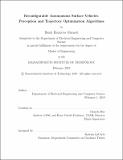| dc.contributor.advisor | Daniela Rus. | en_US |
| dc.contributor.author | Gheneti, Banti Henricus. | en_US |
| dc.contributor.other | Massachusetts Institute of Technology. Department of Electrical Engineering and Computer Science. | en_US |
| dc.date.accessioned | 2019-07-15T20:32:50Z | |
| dc.date.available | 2019-07-15T20:32:50Z | |
| dc.date.copyright | 2019 | en_US |
| dc.date.issued | 2019 | en_US |
| dc.identifier.uri | https://hdl.handle.net/1721.1/121672 | |
| dc.description | This electronic version was submitted by the student author. The certified thesis is available in the Institute Archives and Special Collections. | en_US |
| dc.description | Thesis: M. Eng., Massachusetts Institute of Technology, Department of Electrical Engineering and Computer Science, 2019 | en_US |
| dc.description | Cataloged from student-submitted PDF version of thesis. | en_US |
| dc.description | Includes bibliographical references (pages 105-110). | en_US |
| dc.description.abstract | Autonomous Surface Vehicles (ASV) are a highly active area of robotics with many ongoing projects in search and rescue, environmental surveying, monitoring, and beyond. There have been significant studies on ASVs in riverine, coastal, and sea environments, yet only limited research on urban waterways, one of the most busy and important water environments. This thesis presents an Urban Autonomy System that is able to meet the critical precision, real-time and other requirements that are unique to ASVs in urban waterways. LiDAR-based perception algorithms are presented to enable robust and precise obstacle avoidance and object pose estimation on the water. Additionally, operating ASVs in well-networked urban waterways creates many potential use cases for ASVs to serve as re-configurable urban infrastructure, but this necessitates developing novel multi-robot planners for urban ASV operations. Efficient sequential quadratic programming and real-time B-spline parameterized mixed-integer quadratic programming multi-ASV motion planners are presented respectively for formation changing and shapeshifting operations, enabling use cases such as ASV docking and bridge-building on water. These methods increase the potential of urban and non-urban ASVs in the field. The underlying planners in turn contribute to the motion planning and trajectory optimization toolbox for unmanned aerial vehicles (UAVs), self-driving cars, and other autonomous systems. | en_US |
| dc.description.statementofresponsibility | by Banti Henricus Gheneti. | en_US |
| dc.format.extent | 110 pages | en_US |
| dc.language.iso | eng | en_US |
| dc.publisher | Massachusetts Institute of Technology | en_US |
| dc.rights | MIT theses are protected by copyright. They may be viewed, downloaded, or printed from this source but further reproduction or distribution in any format is prohibited without written permission. | en_US |
| dc.rights.uri | http://dspace.mit.edu/handle/1721.1/7582 | en_US |
| dc.subject | Electrical Engineering and Computer Science. | en_US |
| dc.title | Reconfigurable Autonomous Surface Vehicles : perception and trajectory optimization algorithms | en_US |
| dc.type | Thesis | en_US |
| dc.description.degree | M. Eng. | en_US |
| dc.contributor.department | Massachusetts Institute of Technology. Department of Electrical Engineering and Computer Science | en_US |
| dc.identifier.oclc | 1102056749 | en_US |
| dc.description.collection | M.Eng. Massachusetts Institute of Technology, Department of Electrical Engineering and Computer Science | en_US |
| dspace.imported | 2019-07-15T20:32:47Z | en_US |
| mit.thesis.degree | Master | en_US |
| mit.thesis.department | EECS | en_US |
